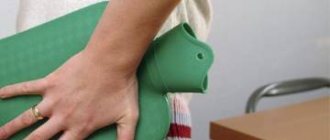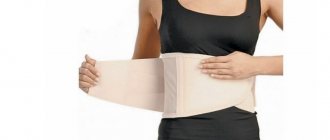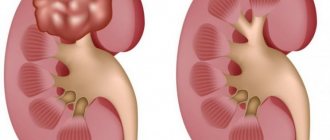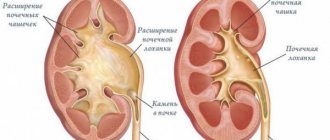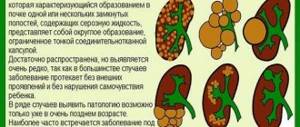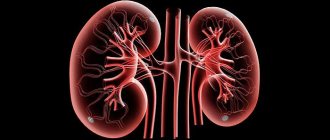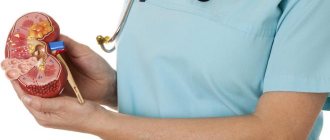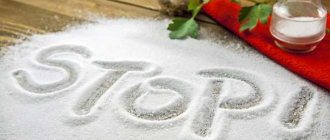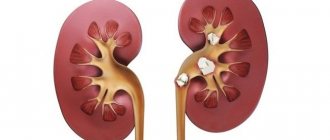Dietary food for nephroptosis: healthy and prohibited foods
Nephroptosis can be congenital or acquired.
In both cases, the patient needs to undergo drug therapy or surgery. In addition, it is recommended to limit physical activity and go on a strict diet.
This article will discuss proper nutrition during kidney prolapse, the main prohibitions and positive aspects of such treatment.
General information about the disease
Nephroptosis is a pathological condition in which one or both kidneys are displaced from their anatomical position. In a healthy person, prolapse occurs no more than 2 cm; in all other cases, we can talk about a severe form of the disease.
If the patient is in a vertical position, the kidney can be found in the abdominal cavity; if the patient is in a horizontal position, it can be found in the pelvis.
Most often, nephroptosis is diagnosed in women; this is associated with pregnancy and childbirth, during which the abdominal muscles are greatly weakened and the organ may begin to wander. The hereditary factor plays a significant role in the development of this pathology. There are 3 stages of the disease:
- Initial, in which the organ can only be felt when the patient takes a breath.
- Second. In this case, in an upright position, the doctor palpates the entire kidney.
- Heavy. The kidney wanders throughout the abdominal region or pelvis, and does not have a clearly defined location. It can only be returned to its original place through surgery.
The main treatment is aimed at eliminating the cause of nephroptosis. The patient is prescribed to wear special underwear; it helps to fix the organ in the required place. In case of inflammatory or infectious processes, drug therapy is carried out.
In severe forms of the disease, surgery is indicated. A prerequisite is compliance with proper nutrition and lifestyle: physical activity is limited, lifting heavy objects is strictly prohibited.
Indications for use of the diet
The main indications for dietary nutrition are displacement of the kidney by more than 2 cm. Nephroptosis can be caused by injury to the organ, constant carrying of heavy objects, pregnancy or childbirth, and poor heredity (weak muscles).
In order to reduce the risk of developing the disease and associated complications, the patient is prescribed a strict diet. In the case of nephroptosis, like many other urological diseases, diet No. 7 is used. Let's look at it in more detail.
Contraindications to food restriction
The selection of a diet is carried out exclusively by a nutritionist; you should never deal with this issue yourself. Contraindications include cardiovascular diseases, liver problems, diabetes, etc.
Nephroptosis is often caused by the patient being overweight, so during treatment you need to strictly monitor the gain of extra pounds.
Nutrition goals
The main goal is to stop the progression of nephroptosis and the development of renal failure. It is very important to follow all recommendations, only in this case can you count on a positive result.
The diet is compiled for each individual, but there are general main directions:
- improving the processes of removing toxins from the body, thus significantly reducing intoxication;
- reducing the load on the organ;
- limiting fluid intake;
- meals should be regular;
- remove dishes and foods that irritate the kidneys;
- balance the patient’s diet as much as possible.
Basic principles and general rules
A patient with nephroptosis should have a complete diet, eating 5-6 times a day in small portions. Liquids are taken in limited quantities, which depend on the condition of the kidneys (about 1.5 liters per day).
Among the basic rules are:
- limiting the calorie content of dishes - no more than 3000 kcal per day;
- exclude fried, spicy and fatty foods, which negatively affect the kidneys;
- you need to enrich your diet with fresh vegetables and fruits;
- restriction of sodium, phosphorus and protein compounds;
- the portion should be no larger than a bent hand into a fist;
- Chew food slowly and thoroughly.
All dishes must be boiled, steamed or stewed. For cooking, it is recommended to use exclusively cold-pressed vegetable oils.
Food necessary for treatment
Diet No. 7, which is used for nephroptosis, is strict; many foods are contraindicated for consumption. Among the permitted ones are:
- whole grain bread or crispbread;
- biscuits;
- dairy products;
- cottage cheese;
- eggs, no more than 2 pcs. in a day;
- lean meat and fish;
- lard in small quantities;
- honey;
- natural marmalade or marshmallow;
- fresh vegetables and fruits;
- pasta from durum wheat;
- vegetable oil (best olive or corn);
- cumin, lemon juice, bay leaf;
- juices and compotes from non-acidic fruits and berries;
- rosehip decoction;
- vegetable or cereal soups;
- potato.
Vegetables can be eaten raw or cooked, such as stew. You can make jellies, mousses, and casseroles from fruits. Every day the menu should be different.
Forbidden food
Diet No. 7 prohibits the use of high-calorie foods; the consumption of phosphorus, table salt and protein compounds is limited. It is very important to maintain the correct balance of carbohydrates, fats and other important microelements.
That is why you need to contact an experienced specialist for advice on dietary nutrition. The patient is prohibited from the following types of products:
- spices;
- meat, fish or mushroom broths;
- sweet carbonated drinks;
- cakes and other similar sweets;
- pickled vegetables;
- canned food
Phosphorus limitation
This element is contained in many foods, most of all in dairy products, nuts, legumes and sweet carbonated drinks. When a person’s kidneys malfunction, salt is poorly excreted from the body, thus phosphorus begins to accumulate.
This causes calcium and other mineral compounds to be washed out of the bones, and as a result, the patient is diagnosed with osteoporosis or other disorders of the musculoskeletal system.
Sodium reduction
Due to the increased load on the kidneys during treatment, the patient is completely excluded from consuming table salt, which contains sodium.
The maximum daily dose is no more than 2 g. It is also prohibited to eat marinades, pickles, sausages, and salted cheeses that contain this element.
Reducing proteins
Dietary nutrition strictly limits protein intake. It is responsible for many functions of the human body: restoration processes in tissues and organs, strengthening muscles, but in case of kidney pathologies it can cause harm.
The breakdown of protein compounds results in the formation of urea, which is excreted by the kidneys. With nephroptosis, these functions are disrupted, and decay products begin to accumulate, causing the development of severe pathologies.
Among the foods that contain proteins are seafood, cheeses, some types of meat, eggs (they can be consumed in small quantities), dairy products and poultry. You should not completely exclude this element from your food; its amount simply needs to be reduced.
Sample menu
Below is an approximate diet for 1 day:
- First breakfast: cottage cheese with fruit or porridge cooked in water, weak tea with honey.
- Second breakfast: boiled egg or omelet.
- Lunch: pureed vegetable soup, steamed cutlets with pasta, dried fruit compote.
- Afternoon snack: pudding or fruit jelly, thin pancakes or pancakes.
- Dinner: stewed vegetables with steamed fish, rosehip broth, biscuits.
Before going to bed, you can drink herbal or green tea with honey.
Drinking regime
In therapeutic diet No. 7, the amount of liquid you drink per day is strictly limited. The daily norm is from 800 to 1000 ml of water, including soups, compotes and juices. The volume is calculated based on the degree of complexity of the person’s disease.
This condition is very important to observe in order to reduce the load on the kidneys. Otherwise, the patient develops edema, inflammatory processes due to retention of urine in the renal pelvis or renal failure.
Helpful information
When treating nephroptosis, it is very useful to use teas from medicinal plants (yarrow, knotweed, St. John's wort, etc.) as a drink; you can prepare them yourself or buy ready-made kidney infusions at the pharmacy.
Since salt is excluded from the diet, it is recommended to add dried dill seeds, bay leaves or lemon juice to add flavor to dishes.
If during treatment the patient develops negative symptoms (nausea, dizziness, intestinal disorders, etc.), then it is necessary to immediately consult a doctor, who will determine the cause of these processes and adjust the diet.
The duration of dietary restrictions depends on the severity of the disease; it is determined by the doctor individually for each patient. Naturally, during therapy you need to limit visiting fast food restaurants and eating foods with a chemical composition.
Kidney prolapse is a common kidney pathology. In addition to drug treatment or surgery, patients with this diagnosis are prescribed a special diet.
Diet No. 7 is considered quite strict, so the patient will need to limit the consumption of many foods. If you follow all the doctor’s recommendations, the level of positive results of therapy increases significantly.
We recommend other articles on the topic
Source: https://UroHelp.guru/pochki/nefroptoz/dieticheskoe-pitanie.html
Restore full functioning and prevent inflammation
Dietary nutrition is necessary at all three stages of the disease. It is not a medicinal method, but it can reduce pain in this disease due to the intake of substances into the body that increase the regeneration of kidney tissue, restore their functioning and have a beneficial effect on the human immune system. Non-drug treatment also affects the causes that provoked the onset of the disease, among which it should be noted:
- sudden weight loss;
- constant stress;
- infectious diseases;
- weakening of abdominal muscle fibers;
- decreased muscle tone;
- deterioration in the functioning of the spine;
- weakening of the body's immune defense.
A therapeutic diet for kidney prolapse is needed primarily to reduce the load on the organ, which will slow down the development of the disease. Therapy for nephroptosis begins with the use of conservative therapy and the prescription of a special type of diet, but you cannot choose a diet on your own. When prescribing a diet, the doctor is guided by the form and stage of development of the disease, taking into account the presence of underlying diseases, for example, heart disease.
If you adhere to the recommendations and rules of diet No. 7, you can cure the disease faster and also prevent the development of complications - renal failure. Special nutrition for nephroptosis has the following goals:
- speed up the process of removing harmful substances;
- reduce consumption of foods that irritate the organ;
- facilitate kidney function;
- maintain the necessary water balance;
- ensure the supply of vitamins and minerals;
- reduce swelling, stabilize blood pressure.
Diet for kidney prolapse (nephroptosis) – Website about hernias and their treatment
In addition, it is recommended to limit physical activity and go on a strict diet.
This article will discuss proper nutrition during kidney prolapse, the main prohibitions and positive aspects of such treatment.
Special nutrition for nephroptosis of the right kidney - treatment with food for displacement of the right kidney
Mild aching pain in the lower back when standing for a long time, minor swelling of the legs in the evening and under the eyes in the morning. Signs of overwork rather than serious illness. If pathology is detected in a timely manner, proper nutrition for nephroptosis of the right kidney, special exercises will speed up recovery and eliminate surgery.
Nephroptosis - what is the essence of the disease
Kidney prolapse is a secondary pathology. It is not provoked by a disease of the kidney itself, but occurs as a result of weakening of the muscle and fatty tissues that support the organ in its normal state. Treatment of nephroptosis is carried out simultaneously for different purposes.
- Strengthen the muscle and fat tissue of the renal bed. It is the long abdominal muscles that hold the kidneys in their normal position. Together with the fat layer, they form a recess - a bed in which the kidney lies.
- Reduce the load on the organ, normalize its function.
Nephroptosis is a prolapse of the kidney
When the muscles weaken and the kidney begins to migrate more than 2 cm down, the vein and artery that lead to it become stretched. As a result of stretching, the lumen narrows. The inflow and outflow of blood is reduced, and the nutrition of the kidney deteriorates.
The ureter moves down. On the contrary, it shrinks, forming kinks that impair the passage of urine into the bladder.
As a result of stagnation of urine, stones form and viral diseases of the kidneys and bladder occur: pyelonephritis, urethritis, cystitis, glomerulonephritis.
The causes of kidney nephroptosis can be:
- decreased muscle tone;
- obesity;
- sudden weight loss;
- physical inactivity;
- more than 3 births;
- poor nutrition;
- sedentary lifestyle;
- injuries in the lumbar region;
- gastrointestinal diseases;
- chronic constipation;
- alcohol consumption;
- strong physical activity, heavy lifting;
- cold;
- viral diseases of the pelvic organs;
- smoking.
Prolapse of the right kidney is more common. Its natural location is lower. The muscles are attached at an acute angle and weaken faster.
Treatment methods for kidney prolapse at different stages
In normal condition, the kidneys migrate within 2 cm. A displacement of 3–4 cm can be treated with therapeutic methods. If the kidney sags more, falls into the peritoneum and becomes twisted, surgical intervention is necessary. At all stages of treatment, an individual diet is prescribed for kidney prolapse.
Source: https://medlbt.ru/lekarstva/dieta-pri-opushhenii-pochki-nefroptoz.html
Etiology and risk factors
The kidney is not in limbo. It is held in a certain place by the muscles of the abdominal wall, fascia, ligaments, fat capsule, etc. The reasons for the progression of left-sided or right-sided nephroptosis are directly related to the weakening of the above elements.
Clinicians identify several main causes of pathology:
- constant carrying of weights;
- sudden weight loss;
- congenital pathologies of the vascular pedicle and renal bed;
- decreased tone of the abdominal muscles. As a rule, this is observed in the case of sudden weight loss, prolonged labor;
- lower back injuries resulting in partial or complete damage to the ligaments;
- illnesses of an infectious nature, as a result of the progression of which the infection affects the ligaments and tissues surrounding the kidneys.
Special nutrition for nephroptosis of the right kidney - treatment with food for displacement of the right kidney
Mild aching pain in the lower back when standing for a long time, minor swelling of the legs in the evening and under the eyes in the morning. Signs of overwork rather than serious illness. If pathology is detected in a timely manner, proper nutrition for nephroptosis of the right kidney, special exercises will speed up recovery and eliminate surgery.
Nutrition for prolapse of the right kidney
The diet for each patient is prescribed individually. The doctor takes into account the patient’s general condition, the degree of prolapse, the condition of muscle and fat tissue. For example, in most cases, fat intake is limited. When thinning the fat layer, the patient is recommended to eat more animal fats and carbohydrates to build and strengthen it.
Self-medication can worsen a person's condition. The amount of salt in all cases is reduced to 5 grams per day. The amount of protein and phosphorus is completely different.
To relieve the load on the kidneys, the patient is prescribed table No. 7. The diet is salt-free, with a limited amount of proteins and phosphorus-containing foods. The amount of vitamins, with the exception of vitamin A, is maximum. Lots of plant fiber. To restore tissue elasticity and normalize weight, the calorie content of food is accurately calculated. The daily norm is divided into 6 meals.
To relieve the load on the kidneys, the patient is prescribed table No. 7
Sodium salts delay the removal of fluid from the body and their accumulation in tissues. This causes swelling and increased blood pressure.
Therefore, during exacerbation of kidney disease, salt is completely excluded. When a relapse becomes chronic, with the onset of remission, salt can be consumed 3–5 grams per day. All dishes are prepared unleavened and salted in a plate before use.
This allows you to add flavor to products using minimal salt.
It is difficult for a person to get used to eating food without taste. You can add to food:
- lemon juice;
- dill;
- caraway;
- cinnamon.
All this is splashed and sprinkled on a dish in a plate. Onions and garlic contain a large amount of essential oils; they should not be eaten if you have diseased kidneys.
To give food a more pronounced taste, you can add lemon juice.
When kidney function is impaired, phosphorus also accumulates in tissues, increasing the concentration of salts. It promotes calcium leaching, leading to brittle bones and decreased hemoglobin production. It is necessary to reduce its intake into the body through food. The highest amounts of phosphorus are found in:
- peanuts;
- cocoa;
- beans;
- beer;
- Coca-Cola;
- dairy products.
In Coca-Cola it is present in the form of phosphoric acid and other compounds. In beer it is formed during the fermentation of hops in combination with malt.
Proteins are necessary for the regeneration of longitudinal muscle cells that support organs and restore their elasticity. On the other hand, during the decomposition of products with a high protein content, creatinine, urea, and other substances related to waste are formed. All of them are excreted by the kidneys, therefore, they increase the load on the organ and accumulate in the tissues. Intoxication of the body occurs.
A patient with nephroptosis should not eat smoked meats and sausages
Prohibited foods for kidney nephroptosis include:
- smoked meats;
- foods fried in a frying pan in fat;
- pickles;
- sausages;
- semi-finished products;
- carbonated drinks;
- meat and fish broths;
- legumes
When uremia is diagnosed, vegetable protein intake is reduced. In addition to legumes, it is found in large quantities in baked goods and confectionery products. Meat and fish contain extractives.
Their number can be reduced using a special cooking technology. First, the products are soaked. Then boil for several minutes in plenty of water without salt. You can add a little celery root and dill.
After this they are baked or stewed.
Butter consumption is limited to 15 grams per day. Mustard and horseradish up to 5 g. Chocolate, coffee, and foods with nutritional supplements should be left until complete recovery and then consumed in a limited manner.
Allowed dishes include vegetable soup
Authorized products include:
- vegetarian soups;
- porridge;
- lean boiled meat;
- turkey and chicken without skin, baked, boiled;
- low-fat sea fish, boiled;
- vinaigrette without sour cucumbers and cabbage;
- dairy products;
- skim cheese;
- vegetables, except sorrel, onions, spinach;
- natural homemade juices;
- green and herbal tea;
- rosehip decoction.
Cereals use buckwheat, rice and sago. Homemade jam without preservatives, honey. Candies without chocolate: fudge, marshmallow, jelly. You can eat mushrooms, bananas, and dried fruits in small quantities.
Special exercises and physical therapy
Physical exercise is recommended to strengthen muscles. The load should be increased gradually, first doing each exercise 3–5 times, and gradually increasing to 20–50 repetitions. It all depends on the physical condition of the person.
- Tilts in all directions.
- In a lying position, raise your legs together, alternately bent at the knee. Pump up your abs by lifting your torso.
- While kneeling, lean on your hands and arch your back.
You can gradually diversify the set of exercises. They should be aimed at strengthening the muscles of the waist and abdomen.
To strengthen the immune system, you should regularly walk, gradually switching to jogging. Be sure to dress appropriately for the weather and insulate your lower back.
Source: https://pochke.ru/vosp_poch/nefr/pitanie-pri-nefroptoze-pravoj-pochki.html
Goals
The patient’s diet should be healthy, varied and sufficiently high in calories; “starvation” diets, despite many prohibitions, are not allowed. The main goal of the nutritional system for nephroptosis is to slow down the development of the disease, as well as reduce the risk of renal failure.
To do this, organizing the menu performs the following tasks:
- Minimizing the load on the kidneys;
- Elimination of the irritating effects of certain products;
- Acceleration of the removal of toxins and waste;
- Optimization of water regime;
- Balance and maximum fortification of the diet;
- Restoring electrolyte balance;
- Reducing swelling, normalizing blood pressure.
Usually, for this pathology, table No. 7 is recommended to the patient; more precisely, this table is taken by the specialist as a basis and adjusted individually.
Restrictions on diet No. 7
- Nephroptosis 2nd degree on the right - Kidneys
Diet for kidney prolapse (nephroptosis): basic principles, menu restrictions, permitted food
When the kidneys prolapse, dietary nutrition is necessary, as with other renal pathologies. The article will discuss the principles of the therapeutic nutrition system for nephroptosis, prohibitions and permitted foods.
Diet for nephroptosis
Kidney prolapse (nephroptosis, wandering kidney) refers to the displacement of an organ vertically relative to the spine. There are many reasons for this pathology, and they lie both in past illnesses and events, and in a person’s lifestyle.
Various conditions cause a decrease in pressure in the peritoneum and a decrease in the tone of muscles and ligaments. Provoking factors can be smoking, alcoholism, injuries, sudden weight loss, physical inactivity, heavy lifting, heredity, multiple births.
Nephroptosis of the right kidney is more common; bilateral and left-sided pathologies are very rare.
Effective treatment of nephroptosis is possible only if all doctor’s prescriptions for conservative therapy are followed, as well as with the use of a certain nutritional system. But is a special diet needed? Yes, it is a well-designed diet that is the key to reducing the load on the kidneys and slowing down the progression of the disease.
Choosing a diet on your own can be dangerous, as can taking medications without your doctor's knowledge. It is important to take into account the form and stage of the disease, concomitant pathologies, especially circulatory diseases, heart diseases, and other types of kidney damage.
The patient’s diet should be healthy, varied and sufficiently high in calories; “starvation” diets, despite many prohibitions, are not allowed. The main goal of the nutritional system for nephroptosis is to slow down the development of the disease, as well as reduce the risk of renal failure.
To do this, organizing the menu performs the following tasks:
- Minimizing the load on the kidneys;
- Elimination of the irritating effects of certain products;
- Acceleration of the removal of toxins and waste;
- Optimization of water regime;
- Balance and maximum fortification of the diet;
- Restoring electrolyte balance;
- Reducing swelling, normalizing blood pressure.
Usually, for this pathology, table No. 7 is recommended to the patient; more precisely, this table is taken by the specialist as a basis and adjusted individually.
Restrictions on diet No. 7
Diet restrictions
The patient is recommended to eat up to 6 times a day, but the portions should be very small. Fluid intake will depend on existing problems and the presence or absence of renal failure. For many patients it is set at a level of 1-1.5 liters per day.
Other important diet rules are:
- The caloric content of the diet per day is 2500-3000 kcal, which will help maintain the fat layer in the kidney at a sufficient level, making the organ more resistant to further displacement.
- There is a ban on frying and consuming foods with refined vegetable oils - they are harmful to kidney tissue. Cooking should be done by boiling, stewing, steaming, baking, and when ready, sprinkle the dishes with cold-pressed oils.
- Paying attention to vegetable dishes, fruits (non-acidic), and cereals.
The main restrictions of the diet for nephroptosis concern substances such as phosphorus and sodium, as well as proteins entering the body.
Phosphorus
Monitoring phosphorus levels in nephroptosis is very important. If even one kidney is malfunctioning, phosphorus is not removed from the blood quickly enough, accumulates in tissues, and increases in the body to dangerous levels. This causes a decrease in calcium, which is directly dependent on phosphorus. Calcium deficiency provokes the development of osteopenia and even osteoporosis, the patient’s bones become brittle.
Phosphorus is found in a huge number of foods, but there are foods where it is present in high concentrations.
The patient's menu should not include:
- Ice cream;
- Whole milk;
- Cheeses;
- Peas;
- Beans;
- Cocoa;
- Beer;
- Soda;
- Peanut butter.
Squirrels
Proteins are important for the body of any person, because they are building materials for new cells, raw materials for tissue repair and muscle building.
But after receipt and processing, proteins are converted into urea, which is subsequently excreted by the kidneys. Various kidney diseases lead to impaired kidney function and the inability to process proteins in the same volume.
There is only one conclusion - to avoid blood contamination, the amount of protein in the diet will have to be reduced.
In this regard, when a kidney prolapses, you need to limit foods such as:
- Fish, seafood;
- Meat;
- Eggs;
- Bird;
- Dairy food;
- Legumes.
It is impossible to completely abandon proteins, but a number of animal proteins can be replaced with plant proteins, which are found in greens, grains, some vegetables, and fruits. The protein requirement per day is usually 20-25 g.
protein in food
Sodium
Sea salt, table salt and all over-salted foods contribute to water retention in the tissues, and with diseased kidneys this process develops even faster.
In addition to the appearance of swelling on the face, body and legs, the patient experiences surges in blood pressure. Reducing sodium in your diet can greatly reduce the burden on your kidneys.
If there is too much sodium in the body, a person becomes very thirsty.
It is better to avoid foods that contain a lot of sodium altogether. This:
- Pickles, marinades;
- Salted fish and snacks;
- Canned food;
- Processed cheeses;
- Olives and other canned vegetables;
- Sausage;
- Smoked meats;
- Fast food.
It is better not to salt homemade food at all during cooking, but add a little salt to the plate. The daily norm for kidney prolapse is usually set at 3-5 g.
If the kidneys prolapse, as with any other organ disease, you will have to give up all junk food. The main prohibitions are formulated above.
Doctors advise eliminating or severely limiting the following foods:
- Meat and fish broths;
- Mushrooms in any form;
- Carbonated drinks;
- All legumes;
- Cream pies, cakes;
- Pickled vegetables;
- Any products with a lot of chemical additives;
- Refined food;
- Low-quality vegetable fats;
- Coffee;
- Strong tea;
- Chocolate;
- Caviar;
- Mineral waters with a lot of sodium;
- Ketchup, mayonnaise.
Dairy products are consumed sparingly, especially cheese, full-fat sour cream and cream, but they cannot be completely abandoned. As for vegetables, you should avoid sorrel, spinach, parsley, radishes, celery, onions (raw), garlic (raw).
What can a sick person eat?
Restrictions on foods during kidney prolapse are serious, but there are even more healthy and tasty foods that you can eat. Among plant foods, watermelons, zucchini and cucumbers are especially needed, but when kidney failure occurs, they are consumed very limited due to their high water content.
You are allowed to drink rosehip infusion, some herbal decoctions, tea with milk and sugar. It is advisable to purchase bread and cookies from whole grains, with bran. In moderation, fermented milk, cottage cheese, eggs are useful (up to 1-2 per day, no more). Lean meat and lard, fruit-based sweets without artificial additives, and honey are consumed little by little.
The patient is allowed porridge, hard grain pasta, vegetable and cereal soups, non-acidic fruits and berries, and juices. Dill, cumin, lemon juice, cinnamon, and bay leaf can partially replace salt in dishes, giving them a brighter taste.
For dressings, it is better to use olive, sunflower, and corn oil. You can also eat pancakes and pancakes, dietary fish, potatoes, any vegetable dishes (stews, salads), casseroles.
It is better to prepare sauces at home using tomatoes, sour cream, and vegetables.
An example of lunch during a diet for kidney nephroptosis:
- Vegetable borscht with sour cream
- Boiled meat, mashed potatoes
- Cucumber salad with olive oil
- Rose hip decoction
Source: https://gidmed.com/nefrologiya/lechenie-pochek/narodnye-metody/dieta-pri-nefrpptoze.html
What can a sick person eat?
Plant foods are replaced by animal foods; vegetables and fruits that have a diuretic effect - cucumbers, zucchini or watermelon - are especially recommended. The patient can make porridge, cook durum pasta, and vegetable soups. It will be difficult to replace salt in dishes, but you can, for example, use dried dill, lemon juice or bay leaf. Stews and casseroles made from potatoes, tomatoes, and vegetable salads will be useful. It is better to use sunflower or olive oil as dressings.
Diet for kidney nephroptosis
- 1 Main principles
- 2 Diet restrictions
- 3 Help with restrictions
A special diet for kidney prolapse (nephroptosis) will help to significantly reduce the risk of complications and stop the development of the process. Each menu is developed individually for each patient by the attending physician based on medical history.
The main goal of the diet is to reduce the load on both kidneys, eliminate foods that cause severe irritation to the kidneys and increase the rate of filtration and removal of waste and toxins, and improve the water-salt balance in the body. Treatment of nephroptosis (prolapse of the kidney) is carried out using a specially developed Diet No. 7.
Main principles
Diet for kidney prolapse No. 7 helps remove edema and lower blood pressure. The principle of action is based on limiting the consumption of salty, protein foods and foods with a high phosphorus content.
The healing table has a high calorie content and high energy value. Experts recommend that if you are diagnosed with kidney prolapse, increase the content of unsaturated fatty acids in your diet.
The leading property of such acids is the absorption of bad cholesterol, which clogs blood vessels and interferes with the normal functioning of the kidneys.
The diet has a basic condition, it lies in the fact that any restrictions in food must be accompanied by additional use of vitamin complexes, all medications should be taken only after consultation with a specialist and as prescribed.
The diet for kidney nephroptosis requires compliance with the following 4 main principles:
- Meals should be fractional, the menu is divided into 6 meals.
- A serving for 1 meal should be made in a volume that will fit in your palm.
- Strict restriction of water intake, no more than 1 liter should be drunk.
- Eating should not be done on the run, and not as a snack; food should be chewed slowly.
Diet restrictions
The key feature is feeding the body with all kinds of components, while the patient observes strict restrictions. When the kidneys prolapse, you should limit the intake of salts, phosphates and proteins.
Nephroptosis of the kidney is often accompanied by an increased level of phosphorus in the urine. This is due to the fact that the element does not have time to filter out and its accumulation leads to an imbalance of calcium-phosphorus metabolism.
Excess calcium, in turn, leads to various diseases of bones and joints. Therefore, the diet includes foods that accelerate the metabolism of phosphorus or contain very little of it.
The following foods should be avoided: cheese, yogurt products, various types of nuts, legumes, drinks containing gas.
Proteins are the building blocks of the whole body, but they put a lot of stress on the kidneys. In this case, experts strictly recommend giving up high-protein foods during the diet for nephroptosis so that the kidneys can continue their recovery during therapeutic therapy without stress. The following foods should be avoided: cheese, meat, seafood, dairy products and eggs.
Salts also put an increased burden on the kidneys. Salt is an element that strongly retains fluid, so it plays a bad role when the kidneys prolapse.
It is recommended to greatly reduce salt-containing foods and switch to a more bland diet.
List of prohibited foods: pickled, salted vegetables, canned foods (fish, meat, vegetables and fruits), foods prepared by smoking.
Help with restrictions
The diet for kidney prolapse is quite strict, but some foods can help the kidneys function normally, which, on the one hand, are prohibited for consumption, but on the other hand, if consumed in moderation, help fight the disease:
- Homemade milk and cottage cheese that do not contain third-party additives. They help remarkably against intoxication and slagging in the body, removing harmful elements.
- Flavoring salt substitutes such as lemon juice, cumin, dried dill and cinnamon. Such seasonings significantly accelerate the regeneration of kidney tissue and put various metabolic processes in order, being a kind of phytoprophylaxis for the kidneys.
It is necessary to be attentive to your body; overeating also puts a strain on the kidneys, subsequently increasing weight. By following all the recommendations of your doctor, you can get rid of the disease as soon as possible.
Source: https://pochkam.ru/lechenie/dieta-pri-opushhenii-pochki.html
Metabolic functions
In addition, the kidneys maintain constant blood pressure under normal conditions and during blood loss, and it is in them that the main regulator of this indicator is located - the renin-angiotensin-aldosterone system (RAAS).
Also, due to the selective permeability of capillaries in the parenchyma of this excretory organ, a balance of various electrolytes and osmotic components in the blood and tissues is ensured: sodium, potassium, calcium, magnesium, glucose, proteins, acids and many others.
They are also involved in erythropoiesis, since it is in them that the special substance erythropoietin is produced - a stimulator of the synthesis of red blood cells in the bone marrow.
Fully or partially limited products
Dietary nutrition for complicated nephroptosis of the kidneys excludes from the diet fish, mushroom and meat concentrated broths, salt and salty foods - pickles, salted nuts, canned food, sausages, marinades, chips, cheeses, ketchups, salted butter, sauces, bouillon cubes, margarine , refractory animal fats. All types of legumes, cereals and pasta, eggs, whole grain bread, bran, cottage cheese, and nuts are subject to restrictions.
The intake of such products as milk powder, bananas, coffee, curry, dried fruits, sesame seeds, sea fish, meat, seeds, mushrooms, milk formula, chocolate, lentils, and soy products is limited. The consumption of carbonated and alcohol-containing drinks is strictly prohibited.
Table of prohibited products
| Proteins, g | Fats, g | Carbohydrates, g | Calories, kcal | |
Vegetables and greens | ||||
| vegetables legumes | 9,1 | 1,6 | 27,0 | 168 |
| sauerkraut | 1,8 | 0,1 | 4,4 | 19 |
| green onion | 1,3 | 0,0 | 4,6 | 19 |
| bulb onions | 1,4 | 0,0 | 10,4 | 41 |
| canned cucumbers | 2,8 | 0,0 | 1,3 | 16 |
| pickles | 0,8 | 0,1 | 1,7 | 11 |
| radish | 1,2 | 0,1 | 3,4 | 19 |
| white radish | 1,4 | 0,0 | 4,1 | 21 |
| turnip | 1,5 | 0,1 | 6,2 | 30 |
| celery | 0,9 | 0,1 | 2,1 | 12 |
| canned tomatoes | 1,1 | 0,1 | 3,5 | 20 |
| horseradish | 3,2 | 0,4 | 10,5 | 56 |
| garlic | 6,5 | 0,5 | 29,9 | 143 |
| spinach | 2,9 | 0,3 | 2,0 | 22 |
| sorrel | 1,5 | 0,3 | 2,9 | 19 |
Fruits | ||||
| apricots | 0,9 | 0,1 | 10,8 | 41 |
| bananas | 1,5 | 0,2 | 21,8 | 95 |
| nectarine | 0,9 | 0,2 | 11,8 | 48 |
| peaches | 0,9 | 0,1 | 11,3 | 46 |
Mushrooms | ||||
| mushrooms | 3,5 | 2,0 | 2,5 | 30 |
| marinated mushrooms | 2,2 | 0,4 | 0,0 | 20 |
Cereals and porridges | ||||
| semolina | 10,3 | 1,0 | 73,3 | 328 |
| cereals | 11,9 | 7,2 | 69,3 | 366 |
| corn grits | 8,3 | 1,2 | 75,0 | 337 |
| pearl barley | 9,3 | 1,1 | 73,7 | 320 |
| millet cereal | 11,5 | 3,3 | 69,3 | 348 |
Flour and pasta | ||||
| pasta | 10,4 | 1,1 | 69,7 | 337 |
Chocolate | ||||
| chocolate | 5,4 | 35,3 | 56,5 | 544 |
Raw materials and seasonings | ||||
| mustard | 5,7 | 6,4 | 22,0 | 162 |
| ginger | 1,8 | 0,8 | 15,8 | 80 |
| ketchup | 1,8 | 1,0 | 22,2 | 93 |
| mayonnaise | 2,4 | 67,0 | 3,9 | 627 |
| ground black pepper | 10,4 | 3,3 | 38,7 | 251 |
| tomato sauce | 1,7 | 7,8 | 4,5 | 80 |
Cheeses and cottage cheese | ||||
| cottage cheese | 17,2 | 5,0 | 1,8 | 121 |
Meat products | ||||
| pork | 16,0 | 21,6 | 0,0 | 259 |
| salo | 2,4 | 89,0 | 0,0 | 797 |
Bird | ||||
| smoked chicken | 27,5 | 8,2 | 0,0 | 184 |
| duck | 16,5 | 61,2 | 0,0 | 346 |
| smoked duck | 19,0 | 28,4 | 0,0 | 337 |
| goose | 16,1 | 33,3 | 0,0 | 364 |
Fish and seafood | ||||
| dried fish | 17,5 | 4,6 | 0,0 | 139 |
| smoked fish | 26,8 | 9,9 | 0,0 | 196 |
| black caviar | 28,0 | 9,7 | 0,0 | 203 |
| salmon caviar granular | 32,0 | 15,0 | 0,0 | 263 |
| canned fish | 17,5 | 2,0 | 0,0 | 88 |
Oils and fats | ||||
| animal fat | 0,0 | 99,7 | 0,0 | 897 |
| cooking fat | 0,0 | 99,7 | 0,0 | 897 |
Juices and compotes | ||||
| tomato juice | 1,1 | 0,2 | 3,8 | 21 |
| * data is per 100 g of product | ||||
How dangerous is the disease?
A well-designed diet is an indispensable condition for the favorable course of the disease. However, it must be remembered that independent selection of a diet, as well as self-medication with medications, are unacceptable and lead to dire consequences. When choosing food products for nephroptosis, not only the stage of the disease is taken into account, but also the complications associated with it. If nephroptosis occurs in parallel with diseases of the gastrointestinal tract, it is necessary to obtain a consultation with a gastroenterologist on this issue before switching to dietary nutrition.
Prolapse of any internal organ is a rather dangerous phenomenon. The normal displacement of the kidneys, which is safe for the body, is no more than 2 cm. The pathological condition of the internal organ is most often found on the right side of the body.
It is the right kidney that most often finds itself in an unusual position in relation to other internal organs. Why does this particular kidney suffer? This phenomenon is associated with the physiological characteristics of the body. The renal system is connected by special plates that are located between the two kidneys. The angle between the front and back plate is slightly larger on the right side. It is he who causes prolapse of the right organ.
- Exercises for nephroptosis: an effective complex
There are three stages of changing the natural position of the kidney in the body. At the first stage, the wandering kidney is easily detected. It can also be felt independently through the abdominal wall. As you exhale, such a kidney moves under the ribs. At the second stage, the affected internal organ can completely emerge from the hypochondrium. The movement of the organ affected by the disease is directly related to the position in which the person himself is. At this stage of nephroptosis, it is not difficult for the organ to rotate around its axis. At this time, the risk of the onset and development of kidney infectious diseases increases sharply. At the second stage, many patients begin to have problems with blood circulation and the functioning of the cardiovascular system; at this time, pyelonephritis occurs, which, due to the prolapse of the organ, is much more severe.
The third stage of the disease is considered the most severe. In the second and third stages, only surgical treatment can return the organ affected by the disease to its natural position.
Return to contents
Causes
First of all, doctors tend to consider the main cause of nephroptosis to be a decrease in intra-abdominal pressure with low smooth muscle tone and dysfunction of the ligamentous apparatus. Accordingly, the reasons for kidney prolapse lie both in lifestyle and in previous diseases. The risk group includes people whose characteristics can be applied:
- antisocial lifestyle. Tobacco smoking and regular alcohol consumption negatively affect muscle tone and the functioning of ligaments. Accordingly, the risk of developing nephroptosis in antisocial elements is higher;
- rapid loss of body weight. This may be due to a previous illness, or due to diet (or prolonged fasting, especially in extreme conditions), or due to some therapy. When the renal fat layer becomes thinner, its mobility occurs, and also due to weight loss, intra-abdominal pressure drops significantly, which entails hypermobility of the internal organs;
- various tissue injuries in the lumbar region. We are talking not only about bruises or falls from a height, industrial and domestic injuries, but also about surgical intervention localized in the subrenal region;
- aging of the body, which entails weakening of both the muscular and ligamentous apparatus;
- a sedentary lifestyle, leading to atrophy of the muscular system;
- pregnancy - multiple births, or during the rehabilitation period after preliminary birth;
- strength sports, excessive passion for fitness. Great physical activity can lead to stretching of the muscle fibers of the ligamentous apparatus of the kidneys;
- specialties associated with heavy physical labor (sleeper layers, loaders, etc.), “vertical” work (salesmen, hairdressers, surgeons, etc.), or with vibrations (drivers, etc.);
- genetic predisposition due to possible weakening of the ligamentous apparatus.
Every year the list of possible causes is updated and refined. Thus, it was believed that the work of a courier could lead to nephroptosis, but later studies revealed a discrepancy between these ideas, since the courier, although he is in an upright position most of the day, is constantly moving, which has a beneficial effect not only on muscle tone, but also on the ligamentous apparatus kidney
